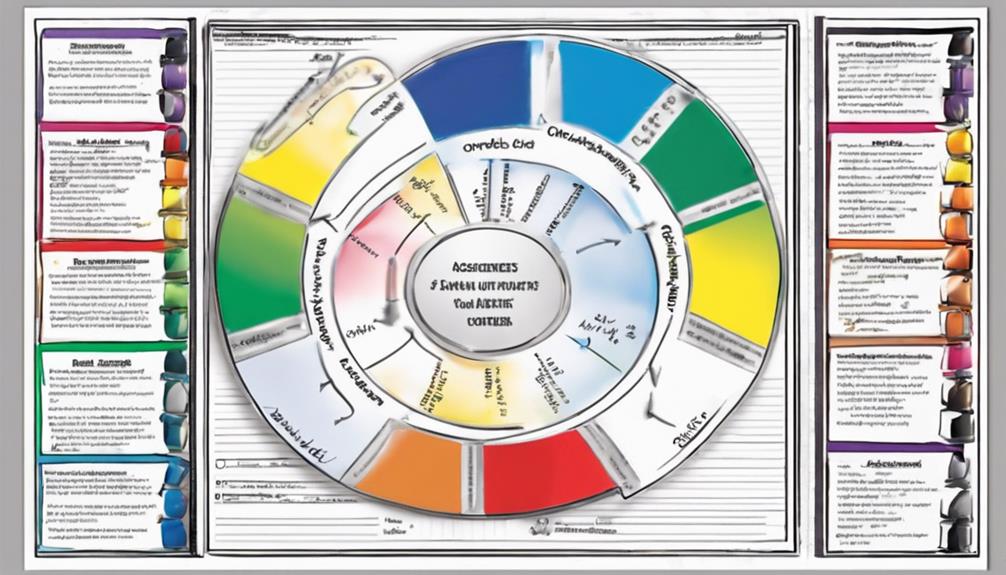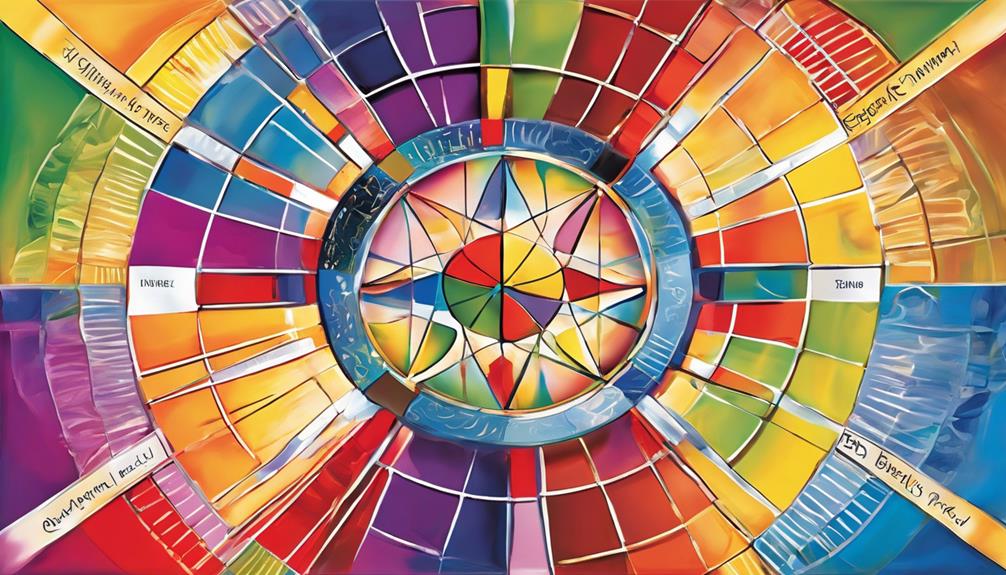Do you believe you know your team thoroughly?
Well, think again. Effective DISC assessment team building exercises can uncover hidden strengths and challenges you never knew existed.
These structured activities go beyond the surface and delve into the core of team dynamics, fostering a deeper understanding that can lead to significant improvements in collaboration.
Key Takeaways
- Hands-on activities like Personal DiSC Badges and Role Play deepen understanding.
- Communication exercises like Communication Swap enhance team interaction.
- Conflict resolution activities focus on understanding styles and mediating conflicts.
- Collaboration exercises promote inclusivity, creativity, trust, and cooperation.
Understanding DISC Styles Through Activities
By engaging in hands-on activities such as Personal DiSC Badge creation and DiSC Role Play, participants can gain a deeper understanding of the various DiSC styles and their implications within team dynamics. These activities serve as effective DiSC Training Activities by allowing individuals to embody different personality styles, fostering empathy and understanding towards others' behavioral tendencies.
Through the creation of Personal DiSC Badges, team members can visually represent their dominant traits, facilitating open discussions about how these traits influence their communication tactics and tips. In DiSC Role Play exercises, participants can step into the shoes of different personality styles, experiencing firsthand the challenges and strengths each style brings to team interactions.
Understanding personality styles through experiential learning not only enhances self-awareness but also promotes a more harmonious team environment. By actively participating in these activities, individuals can identify their own preferences and adapt their communication strategies to better suit the diverse behavioral styles present within the team.
This hands-on approach to exploring DiSC styles lays the foundation for improved teamwork, as team members learn to leverage their strengths and accommodate differences for enhanced collaboration and job role alignment.
Enhancing Communication Exercises

To enhance team communication effectiveness, incorporating targeted exercises that align with DiSC principles can significantly improve understanding and interaction among team members. When focusing on enhancing communication through DISC training, specific exercises can be beneficial:
- DiSC Communication Swap activity: Participants discuss how they'd handle various communication scenarios based on their DiSC styles.
- Feedback Carousel exercise: Individuals practice giving and receiving feedback effectively using DiSC principles.
- Email Decoding game: Participants decode and respond to emails written in different DiSC styles to enhance communication understanding.
- Silent Meetings activity: Encourages non-verbal communication through gestures and expressions to improve understanding of different DiSC styles in communication.
Conflict Resolution Activities
When considering Conflict Resolution Activities in DiSC training, understanding the diverse approaches of different DiSC styles becomes essential for effectively managing and resolving conflicts within teams. Team members participating in these activities gain insights into how their DiSC style influences their conflict resolution strategies. By learning about appropriate communication tactics based on their DiSC Profile, individuals can navigate conflicts more effectively. Role-playing scenarios are commonly used in these training sessions to simulate real-world conflict situations and practice resolving them using DiSC principles.
Style Mediation exercises provide an opportunity for team members with different DiSC styles to work together and find common ground in conflicts. This fosters a deeper understanding of each other's perspectives and promotes collaboration. Additionally, conflict mapping activities help teams analyze past conflicts to identify patterns, learn from mistakes, and develop strategies for improving future interactions. Through these conflict resolution activities, teams can enhance their problem-solving skills, strengthen relationships, and create a more harmonious work environment.
Promoting Collaboration Exercises

Understanding the importance of fostering collaboration within teams, the focus shifts towards implementing Promoting Collaboration Exercises to enhance teamwork and communication skills. These exercises play a crucial role in enhancing team dynamics and promoting a more cohesive work environment.
Here are some key elements of Promoting Collaboration Exercises:
- Encouraging active participation: By encouraging all team members to actively participate, these exercises ensure that everyone's voice is heard, leading to a more inclusive decision-making process.
- Fostering creativity: Promoting collaboration exercises provide a platform for team members to share ideas freely, fostering creativity and innovation within the team.
- Building trust: Through these exercises, teams can build trust among members, creating a supportive environment where individuals feel comfortable sharing their thoughts and opinions.
- Enhancing relationships: Collaboration exercises help strengthen relationships among team members, leading to better communication and cooperation in achieving common goals.
Celebrating and Appreciating Team Dynamics
Celebrating team dynamics through structured recognition activities fosters a culture of appreciation and strengthens interpersonal connections within the team. By incorporating DiSC styles into appreciation exercises, such as the DiSC Appreciation Circle and Achievement Board, team achievements are highlighted based on individual strengths.
The DiSC Awards Night adds a touch of fun by creating personalized awards that celebrate the unique qualities of team members. Moreover, the Strength Story activity provides a platform for sharing anecdotes that showcase how different DiSC styles contribute to the team dynamics.
Utilizing Thank You Notes tailored to DiSC styles further enhances communication and demonstrates gratitude in a manner that resonates with each team member's preferences. These activities not only acknowledge individual contributions but also reinforce the value of diverse strengths and improve overall team cohesion.
Celebrating and appreciating team dynamics in this manner fosters a positive environment where team members feel acknowledged and motivated to continue collaborating effectively.
Frequently Asked Questions
How Do You Use Disc Assessment for Team Building?
We leverage DiSC assessments for team building by identifying communication styles and tailoring exercises to each member's strengths. Understanding DiSC profiles enhances collaboration. Incorporating results into discussions and activities fosters empathy and cohesion.
What Is the DISC Model in Team Dynamics?
Understanding the DISC model in team dynamics is crucial. It categorizes behavior into four styles, guiding communication and collaboration. Each style brings unique strengths. Appreciating these differences leads to cohesive, productive teams.
How Do You Facilitate a DISC Session?
In facilitating a DISC session, we introduce the DiSC model, explain behavior styles, and discuss their impact on team dynamics. Utilize interactive activities like group discussions, role-playing, and team-building games to engage participants in understanding their styles.
What Are Effective Uses of an Assessment Like Disc?
Understanding diverse personalities and communication styles through DiSC assessments fosters effective collaboration. It empowers teams to leverage strengths, navigate conflicts, and enhance productivity. Utilizing these insights leads to cohesive teamwork, improved relationships, and elevated performance.
How can using Excel for DISC assessment worksheets improve team collaboration?
Using Excel for DISC assessment worksheet tips can greatly improve team collaboration. By organizing and analyzing the results in a clear, accessible format, team members can better understand each other’s communication styles and work more effectively together. This can lead to improved teamwork, communication, and overall productivity.
Conclusion
In conclusion, the team building exercises utilizing DISC assessments have proven to be invaluable tools for enhancing collaboration within teams.
By engaging in activities that promote understanding of different communication styles, conflict resolution, and overall appreciation for team dynamics, members can work together more effectively.
Through these tailored exercises, teams can strengthen their relationships and achieve better outcomes.
So, let's embrace the power of DISC assessments and watch our collaboration soar to new heights!









